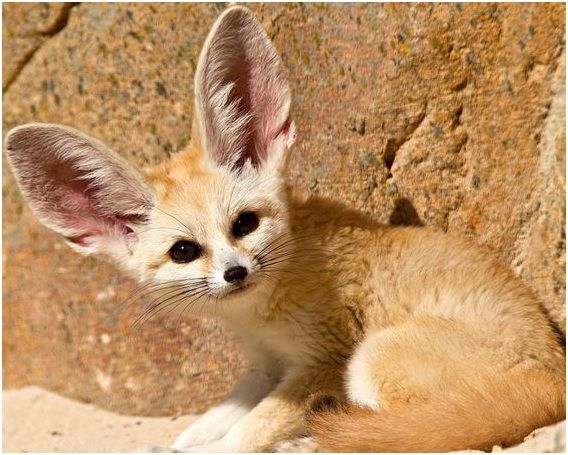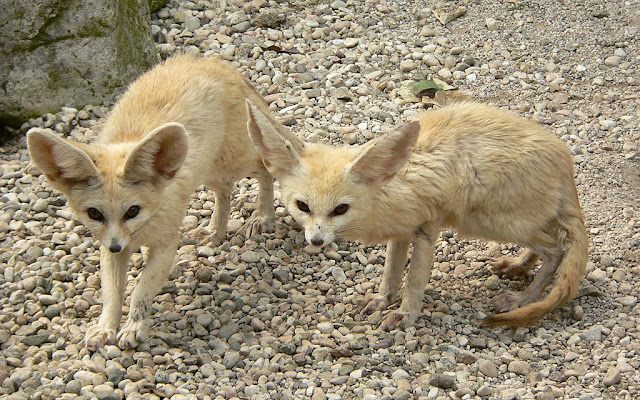THE FENNEC FOX
ABOUT THE FENNEC FOX
The fennec fox is a small crepuscular fox native to the deserts of North Africa, ranging from Western Sahara and Morocco to the Sinai Peninsula. Its name comes from the species' Arabic name: fanak (فَنَك). Its most distinctive feature is its unusually large ears, which serve to dissipate heat and listen for underground prey. The fennec is the smallest fox species, and by extension, the smallest canid overall.
Its coat, ears, and kidney functions have adapted to the desert environment with high temperatures and little water. It mainly eats insects, smaller mammals and birds. The fennec has a life span of up to 14 years in captivity and about 10 years in the wild, being the fox species with the longest life span. Its main predators are the Verreaux's eagle-owl, jackals and other large mammals. Fennec families dig out burrows in the sand for habitation and protection, which can be as large as 120 m2 and adjoin the burrows of other families.
Precise population figures are not known but are estimated from the frequency of sightings; these indicate that the fennec is currently not threatened by extinction. Knowledge of social interactions is limited to information gathered from captive animals. The fennec's fur is prized by the indigenous peoples of North Africa, and it is considered an exotic pet in some parts of the world.
Reproduction and behavior
- Gestation: 50-52 days.
- Young per birth: 1-4
- Weaning: 61-70 days.
- Sexual maturity: 9 months.
- Life span: around 10 years, up to 14 in captivity.
- Breeding season: Between January and February, but can produce a second litter if the first is lost.
Diet and interaction with the environment
The fennec fox has sand-colored fur which reflects sunlight during the day and helps keep it warm at night. Its nose is black. Its tapering tail has a black tip. Its long ears have longitudinal reddish stripes on the back and are so densely haired inside that the external auditory meatus is not visible. The edges of the ears are whitish, but darker on the back. The ear to body ratio is the greatest in the canid family and likely helps in dissipating heat and locating vertebrates. It has dark streaks running from the inner eye to either side of the slender muzzle. Its large eyes are dark. The pads of its paws are covered with dense fur, which facilitates walking on hot, sandy soil.
Habitat
They're native to: Algeria, Chad, Egypt, Libya, Mali, Mauritania,
Morocco, Niger, Sudan, Tunisia, Western Sahara, and probably in
Israel, Jordan, Kuwait, Oman, Saudi Arabia and Yemen. Widespread in
Northern Africa, ranging from Western Sahara and Mauritania to Northern Sinai. Its
occurrence on the Arabian Peninsula is unclear because of confusion
with the young of the Arabian subspecies of Rüppell’s Fox.
Their habitat consists in arid desert environments. Stable sand dunes are the ideal habitat, although they also live in very sparsely vegetated sand dunes near the Atlantic coast. Ability to burrow in sandier substrates than other Canids provides them with a competitive advantage in dune systems. Their conservation status is Least Concern. Regional status: Legally protected in Morocco, Algeria (is even considered the national animal of the country), Tunisia and Egypt. Common throughout the Sahara. Construction of roads and new human settlements is increasing the disturbance and risk to some populations. It is commonly trapped and sold commercially in Northern Africa for exhibition or sale to tourists.
Physiognomic information:
- Body length: 24-41 cm (♂), 34-40 cm (♀).
- Tail length: 12-31 cm.
- Height: 15-20 cm.
- Weight: 0.7-1.9 kg.
- Skull: 8.3 cm.











.jpg)












No hay comentarios:
Publicar un comentario